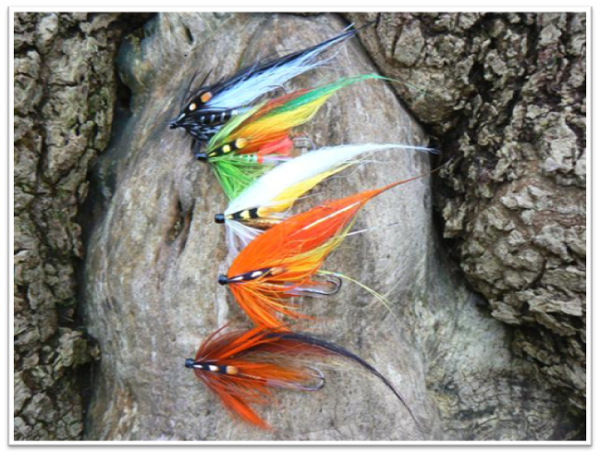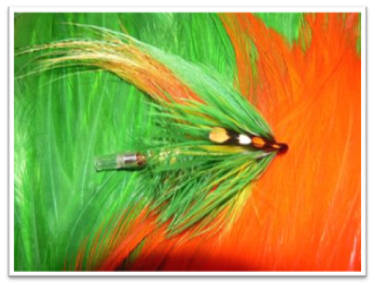
The Temple Dog
ARTICLE BY INDREK KONGATS, DECEMBER 16, 2016
I first heard about this breed of flies, curiously named Templedog, from my friend Matt Hayes, owner of the Winsnes Fly Fishing Lodge on the historical Gaula River in Norway.
It seems the Scandinavian fly fishers are always one step ahead of our North American counterparts. “Templedog”, I said, “what’s that?” Well, Matt suggested I visit fly tier Jens Christiansen’s website: www.templedog.mono.net and see the flies for myself. Jens has also been a Winsnes guide or ghilly as they call them across the Atlantic, for four years and has been putting his sports into fish from the beginning with his numerous templedog patterns.

photo by Jens Christiansen
So how did this great fly come about? “The templedog was invented by two very famous Gaula ghillies that went on to become well known Swedish fly fishers - Hakan Norling and Mikael Frodin. Though Frodin has perhaps enjoyed
the greatest fame for his fabulous fly designs, the templedog's invention is probably more due to Norling,” states Matt. “I know Hakan quite well. The most important thing to remember is that the templedog is a fly with fantastic mobility due to the pulsing of the soft materials used in the wing construction. Norling once told me, “when we tried out the first prototypes, we simply hung them in the current at our feet and it looked as if the fly wanted to swim off - then we knew we were onto a winner!'”
There can be no doubt that the templedog has changed salmon fishing, mainly because of its use of a very mobile winging material called Templehair, a combination of stiff guard hairs and soft underlying wool. The templehair comes alive in the water, displaying a mobility that makes traditional hair wing flies look dead by comparison. The layered wings can also incorporate varying amounts of flash. Like in the Victorian days, we are once again using really big flies for early season salmon.
Templehair was originally dog hair or fur. Dag Midtgard is a Norwegian importer and distributor of the product and he told me that the term templedog refers to the large bred of dogs that once guarded Tibetan temples. Nowadays it’s illegal to possess real dog pelts so the hair is from some other animal legally harvested such as crossbreed fox, Finnish raccoon or even some goat hair. The characteristics are the same, some better than others but it seems that every fly tier has his or her own favorite.
Scandinavians tie their dogs mostly on tubes, brass, aluminum or plastic and use a variety of hooks ranging from singles to trebles. North American tiers would tie them on plastic tubes with single or double hooks as well as directly onto a spey or double salmon hook ranging in size from 1/0 down to 10, to be legal with no additional weight being added. The length of the finished fly may be as long as 4 inches or as short as one inch.
The goal is to create a fly that is the shape of a tear drop when viewed from the side, below and above. Some have front hackle and jungle cock eyes for greater attraction. “All in all it takes around 30-40 minutes to build up the Templedog with body, wing, flash and hackle. Difficult to tie and incorporating the best and softest natural furs for maximum mobility, these flies are expensive. Are they worth it? Absolutely! Really good templedogs are not easy to obtain but they can be bought on the internet or through top fly shops. We also sell some beautifully tied templedogs at Winsnes. Expect to pay between $12.00 to $15.00 US for a really well tied templedog incorporating the best materials”, claims Jens.
Green Highlander Templedog
Winsnes received its first English “Salmon Lords” in 1882, the same year the famous Green Highlander was invented. The Green Highlander is still a very popular pattern now even more so in the Templedog version.

photo by Jens Christiansen
Material List:
Butt: red floss Body: chartreuse or green highlander floss
Rib: silver
Hackle: yellow and green saddle
Under wing: orange templehair
Middle wing: yellow templehair
Over wing: chartreuse or green templehair
Longest wing: black or dark brown templehair
Flash: red/gold/ green - very few strands
Front hackle: green, chartreuse or yellow feather
Cheeks: Jungle Cock
Step by step directions for tying Jens’ Green Highlander Templedog on a plastic tube:
1) First create the tubes - a small inside a bigger tube. Glue the small tube inside the big tube with superglue and leave 2 cm (0.8 inch) of the smaller tube extended to form the head. 2) Make the body upon the thickest part. 3) Start to make the floss body 4) Tie the hackle pushing the windings tight together. Use one large or two smaller hackle feathers.
5) Start the wing by trimming the orange templehair to the length of the tube. 6) Tie on the yellow middle wing, slightly longer than the under wing. 7) Tie on the green or chartreuse wing, again slightly longer than the wing before. 8) Tie in a few strands of flash. 9) Complete the wing by tying on the black or dark brown over wing, once again slightly longer. 10) Complete the front hackle with green or yellow hackle feathers. 11) The final item will be the Jungle Cock cheeks/eyes. 12) Apply head cement at least 2 times Note: Clean out most of the under fur so as to not make the head of the fly too large.
back to main menu

|